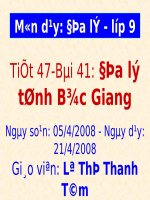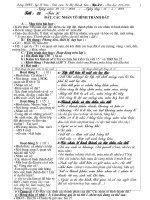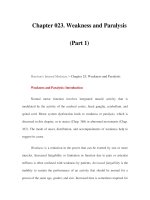Marcro micro econmiy david begg chapter 023
Bạn đang xem bản rút gọn của tài liệu. Xem và tải ngay bản đầy đủ của tài liệu tại đây (88.02 KB, 11 trang )
Chapter 23
Money and modern banking
David Begg, Stanley Fischer and Rudiger Dornbusch, Economics,
6th Edition, McGraw-Hill, 2000
Power Point presentation by Peter Smith
Some key questions
■
Why does society need money?
■
Why do governments wish to
influence money supply?
■
How do financial markets interact
with the “real” economy?
■
What is the relationship between
money and interest rates?
23.2
Money
Any generally accepted means of payment
for delivery of goods or the settlement of
debt
■ Legal money
■
–
■
notes and coins
Customary money
–
IOU money based on private debt of the
individual
■ e.g.
bank deposit.
23.3
Money and its functions
■
Medium of exchange
–
■
Unit of account
–
■
a unit in which prices are quoted and accounts are kept
Store of value
–
■
money provides a medium for the exchange of goods and
services which is more efficient than barter
money can be used to make purchases in the future
Standard of deferred payment
–
a unit of account over time: this enables borrowing and
lending
23.4
Modern banking
■
A financial intermediary
–
■
an institution that specializes in bringing lenders
and borrowers together
■
e.g. a commercial bank, which has a government licence
to make loans and issue deposits
■
including deposits against which cheques can be written
Clearing system
–
a set of arrangements in which debts between
banks are settled
23.5
A beginner’s guide to the financial markets
■
Financial asset
–
■
Cash
–
–
■
a piece of paper entitling the owner to a specified
stream of interest payments over a specified period
Notes and coin, paying no interest
the most liquid of all assets.
Bills
–
–
financial assets with less than one year until the
known date at which they will be repurchased by
the original owner
highly liquid
23.6
A beginner’s guide to the financial markets
(continued)
■
Bonds
–
■
longer term financial assets – less liquid because there is more
uncertainty about the future income stream
Perpetuities
–
an extreme form of bond, never repurchased by the original issuer,
who pays interest forever
■
■
Gilt-edged securities
–
■
e.g. Consols
government bonds in the UK
Industrial shares (equities)
–
–
entitlements to receive corporate dividends
not very liquid
23.7
Credit creation by banks
■
Commercial banks need to hold only a
proportion of assets as cash reserves
–
■
this enables them to create credit by
lending
EXAMPLE:
–
–
suppose the public needs a fixed £10m
for transactions
and the commercial bank maintains a
10% cash reserve
23.8
Credit creation – example
Commercial bank :
Cash Public Money
Liabilities
Assets
ratio cash supply
Deposits Cash Loans Total
% holding
Initial position:
10
100
10
90
100 10
110
Central bank issues £10m extra; the public deposits it
1
110
20
90
110
18.2
10
120
2
110
11
99
110
10
19
129
3
119
20
99
119
16.8
10
129
n
200
20
180
200
10
10
210
23.9
The monetary base and the
money multiplier
■
The monetary base or stock of highpowered money
–
■
the quantity of notes and coin in private
circulation plus the quantity held by the
banking system
The money multiplier
–
the change in the money stock for a £1
change in the quantity of the monetary
base
23.10
The money multiplier
Suppose the banks wish to hold cash reserves R as
as fraction (cb) of deposits (D), and the private sector
wish to hold cash (C) as a fraction (cp) of bank
deposits (D).
Then R = cbD and C = cp D
Monetary base H = C + R = (cb + cp) D
Money supply = C + D = (cp + 1) D
(cp + 1)
So M =
H
(cp + cb)
Money supply = money multiplier × monetary base
23.11









